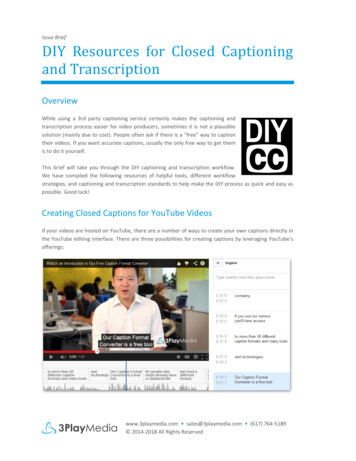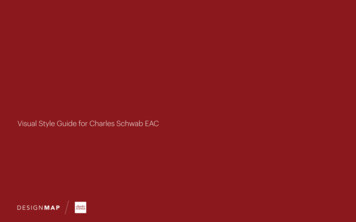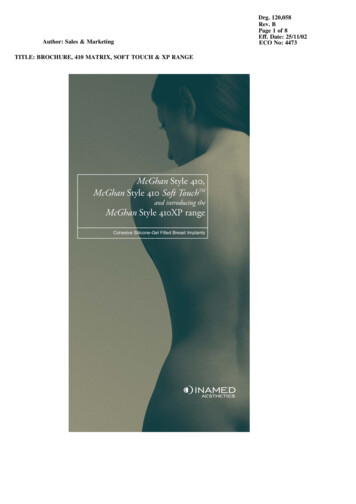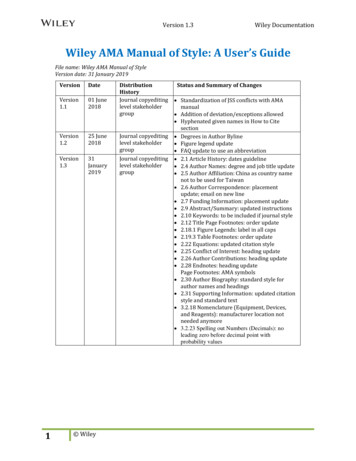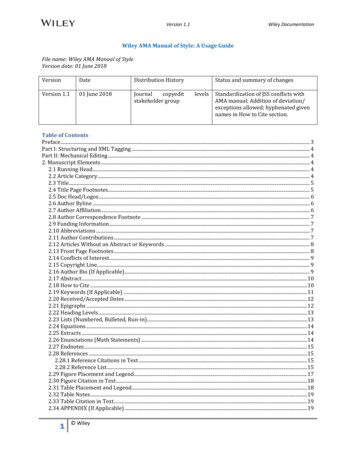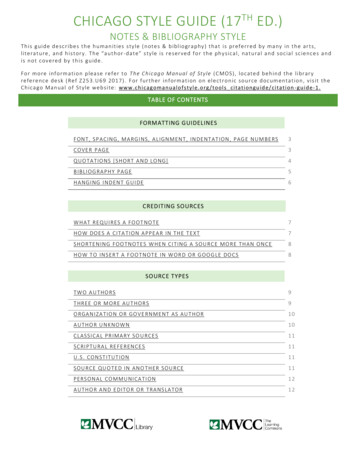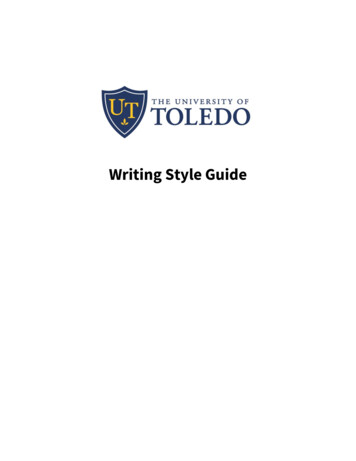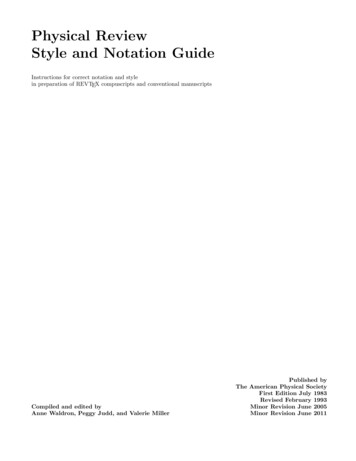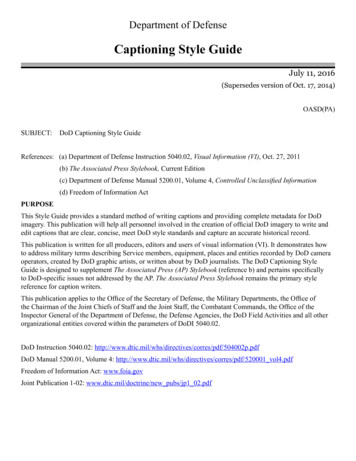
Transcription
Department of DefenseCaptioning Style GuideJuly 11, 2016(Supersedes version of Oct. 17, 2014)OASD(PA)SUBJECT:DoD Captioning Style GuideReferences: (a) Department of Defense Instruction 5040.02, Visual Information (VI), Oct. 27, 2011(b) The Associated Press Stylebook, Current Edition(c) Department of Defense Manual 5200.01, Volume 4, Controlled Unclassified Information(d) Freedom of Information ActPURPOSEThis Style Guide provides a standard method of writing captions and providing complete metadata for DoDimagery. This publication will help all personnel involved in the creation of official DoD imagery to write andedit captions that are clear, concise, meet DoD style standards and capture an accurate historical record.This publication is written for all producers, editors and users of visual information (VI). It demonstrates howto address military terms describing Service members, equipment, places and entities recorded by DoD cameraoperators, created by DoD graphic artists, or written about by DoD journalists. The DoD Captioning StyleGuide is designed to supplement The Associated Press (AP) Stylebook (reference b) and pertains specificallyto DoD-specific issues not addressed by the AP. The Associated Press Stylebook remains the primary stylereference for caption writers.This publication applies to the Office of the Secretary of Defense, the Military Departments, the Office ofthe Chairman of the Joint Chiefs of Staff and the Joint Staff, the Combatant Commands, the Office of theInspector General of the Department of Defense, the Defense Agencies, the DoD Field Activities and all otherorganizational entities covered within the parameters of DoDI 5040.02.DoD Instruction 5040.02: 02p.pdfDoD Manual 5200.01, Volume 4: 01 vol4.pdfFreedom of Information Act: www.foia.govJoint Publication 1-02: www.dtic.mil/doctrine/new pubs/jp1 02.pdf
Table of ContentsSummary of updates3Chapter 1 - Matters of style4Alphabetical listingMilitary unit namesNavy and Marine Corps aviation units41417Chapter 2 - ReferencesTable 1. Military rank abbreviationsTable 2. Force structureTable 3. Selected aircraft and vehiclesTable 4. Selected weaponsTable 5. State names and abbreviationsTable 6. Afghan provinces18182021222223Chapter 3 - Captioning stilland motion imageryThe ABCsThe 5 WsConstructing a captionAdditional rules of constructionPhotographer’s creditSample captions24242426262728Chapter 4 - KeywordingControlled vocabularyStandard format for keywordsGuidelines for selecting keywordsSample keywords2929303032Chapter 5 - Still and motionimagery metadataVisual Information Record IdentificationNumber (VIRIN)VISION ID, DVIANDate ShotOperation/ExerciseHeadline (optional)CaptionKeywordsCommand Shown2333333343434343434Service ShownBase/LocationState/ProvinceCountry/Area/Body of waterRelease StatusRelease AuthorityPhotographer NamePhotographer Home UnitCaption EditorFOIA ExemptionsMetadata cross reference tables3435353535353535363637Chapter 6 - Submitting to DIMOCDVIDS (Released imagery only)Email, AMRDEC SAFE optionsFOUO imageryClassified imageryPhysical imagery404040414141Chapter 7 - Grammar reviewSentence 546Chapter 8 - Manipulation and alterationpolicies and disclosurePhoto illustrations and alterationsProper disclosure of manipulationsExamples47474849Chapter 9Additional Resources50
Summary of updates and changesThis edition of the DoD Captioning Style Guide incorporates many changes refelecting the evolution of digital means of capturing metadata associated with Department ofDefense still and motion imagery products. As digital cameras and systems evolve, oldfashioned means of conveying metadata are rendered obsolete.Most notably, the requirement for slates and Form DD2537 associated with motionimagery are eliminated, effective immediately. The Captioning Motion Imagery chapterin previous editions has also been eliminated; the still imagery captioning and metadatachapters have been updated to reflect applicability to still and motion products.Furthermore, the release status of a given still or motion image is no longer included inthe caption credit line; the release status must be included in the public release instructions (see Chapter 5, Still and motion imagery metadata).Chapter 1, Matters of style: combat rubber raiding craft corporals course Daesh/Da’esh/Daish ISIL LCM names Persian Gulf (change) podium, lectern post-deployment predeployment Ranger redeployment replenishment-at-sea ROTC, Junior ROTC (change) service member (change) submarine West Point World War I, World War II more information on U.S. Navy shiptypesChapter 3, Captioning stilland motion imagery: Removes requirement to include releasestatus in photographer credit line. Removes requirement for submittingDD2537 with motion imagery. Removes requirement for includingslates with motion imagery.Chapter 4, Keywording: Controlled vocabularyChapter 5, Still and motion imagerymetadata: Updates to VISION ID, Keywords, ImageSource, Base/Location, Command Shown,Service Shown Revised guidance for Release Status,Release Authority and ReleaseInstructionsChapter 6, Submitting to DIMOC: All new chapter detailing requirementsand procedures for imagery submission.Joint Combat Camera Center6700 Taylor AvenueFort Meade, MD 20755301-833-4932DSN 312-733-4932JCCC@mail.milwww.dimoc.mil3
Chapter 1Matters of styleThis chapter provides the correct style for commonlyused terms within DoD captions. The list is by nomeans comprehensive; if a term does not appearbelow, refer to The Associated Press Stylebookor Webster’s New World College Dictionary forthe appropriate style and spelling, the NationalGeographic Atlas of the World for place names, or tothe Service-specific fact sheets for the correct spellingof aircraft, vehicles and equipment (see Chapter 10,Additional resources, on page 50).Anzac Capitalize, but do not use all caps. Anzacstands for the Australian and New Zealand ArmyCorps of World War I. Anzac Day is celebratedannually by both nations April 25; U.S. Servicemembers are often present at these celebrations.abbreviations Only use abbreviations on secondreference; the abbreviation must be in parenthesesafter the first reference. Note: The only exceptions tothis are Navy and Marine Corps aviation squadrons(see page 17), NATO, SEAL, USO and abbreviationscovered in the AP Stylebook.assault amphibian battalion Lowercase unlessused in a unit name.aboard Use aboard when referring to people in, onor entering a ship or aircraft. Do not use aboard todescribe being on a land base.U.S. Sailors eat breakfast aboard the guidedmissile cruiser USS Vella Gulf (CG 72) in theMediterranean Sea June 4, 2014.U.S. Air Force Tech. Sgt. Beth Jones, aloadmaster, inspects pallets of supplies aboard aC-130 Hercules aircraft at Joint Base Andrews,Md., April 23, 2014.Afghan cities See Table 6, Afghan provinces, onpage 23 for the proper spelling for several majorcities in Afghanistan.Air Force One Any U.S. Air Force aircraft carryingthe president. The term is a call sign that applies onlywhen the president is aboard the aircraft. The mainaircraft serving in this capacity is the VC-25A.Airman, Airmen Capitalize when referring tomembers of the U.S. Air Force; not capitalized whenreferring to members of foreign air forces.all hands/all-hands Two words as a noun: Thecommanding officer called all hands to the meeting.Hyphenate as an adjective or a compound modifier:The Sailors attended the all-hands call.alongside One word.American flag, U.S. flag Note flag is lowercase.amphibious assault ship Do not capitalize, evenwhen referring to a specific ship. For example: U.S.Sailors and Marines man the rails of the amphibiousassault ship USS Nassau (LHA 4).4aqueous film-forming foam AFFF is acceptableon second reference.Arabian Gulf Do not use. See Persian Gulf.Arabic names Follow AP style for Arabic names.assault amphibious vehicle The Marine Corps’AAV7A1 tracked vehicle. Not amphibious assaultvehicle. Do not confuse with amphibious assaultships.assistant secretary Capitalize before a name as partof a title; use lowercase when the title appears afterthe name.at sea Do not use “at sea” in place of the name of abody of water. If the location is undisclosed, say so,but reference a general body of water or U.S. fleet areaof responsibility. See here.back blast Two words.Bambi bucket Do not use. See helicopter bucket.battalion landing team In unit names, capitalize it,followed by a comma and the unit’s full name.U.S. Marines with Foxtrot Company, BattalionLanding Team, 2nd Battalion, 4th MarineRegiment storm a beach Jan. 23, 2012, as part ofan exercise in Thailand.Blue Angels The Navy’s flight demonstration team.Simply refer to the group as the Blue Angels. The teamcurrently flies the F/A-18 Hornet aircraft.bounding overwatch Jargon. Use maneuver oranother synonym.breech/breach Breech refers to the part of anartillery piece where rounds are loaded. The verbbreach means to penetrate an obstacle or defense; asa noun, breach is the hole in a defense.casualty evacuation CASEVAC is acceptable onsecond reference.cavalry Use lowercase unless it is part of a unit name.Do not confuse with Calvary, which is a religiousterm.
change of command ceremony Do not hyphenatethe compound adjective.Civil Air Patrol The civilian volunteer auxiliary ofthe U.S. Air Force, best known for search and rescue,disaster relief and cadet programs. Although Civil AirPatrol members work closely with the Air Force andthey hold rank within Civil Air Patrol, they are notAirmen. CAP is acceptable on second reference.civilian titles Do not use courtesy titles such Mr.,Mrs., Miss, or Ms. unless requested by the namedperson. Other formal titles such as Dr., Sen. orGov. should be used where applicable. Do not usesuch titles on second reference unless necessary todifferentiate two people with the same last name.close-in weapon system Do not capitalize. CIWS isacceptable on subsequent references.Coast Guardsman, Coast Guardsmen Capitalizewhen referring to members of the U.S. Coast Guard;not capitalized when referring to members of foreigncoast guards.Coast Guard Auxiliary The civilian volunteerauxiliary of the U.S. Coast Guard, best known forboater safety programs. Although Auxiliarists workclosely with the Coast Guard and they hold rankwithin the Auxiliary, they are not Coast Guardsmen.Colombia/Columbia The South American countryis spelled Colombia, and the adjective is Colombian.Columbia is the proper spelling for the university,the former space shuttle and several U.S. cities andprivate-sector organizations.colors When referring to the flag of the UnitedStates, American flag or U.S. flag are the preferredstyles. Do not use in reference to the flags of othernations. Acceptable when referring to unit flags andguidons. For example: The battalion colors werefurled during a transfer of authority ceremony.combat rubber raiding craft Do not use thecommercial term “Zodiac boat.”combined Per Joint Publication 1-02: A termidentifying two or more forces or agencies of two ormore allies operating together. See joint.commandant A job title for the top four-star officerof the U.S. Marine Corps and the U.S. Coast Guard;also used to describe the commanding personnelof academies and other military institutions. Onlycapitalize when used in the official job title before theperson’s name.U.S. Marine Corps Sgt. John Smith shakes handswith Commandant of the Marine Corps Gen.James F. Amos at the Pentagon in Arlington, Va.,June 5, 2012.U.S. Army Command Sgt. Maj. Rory Malloy,left, the commandant of the U.S. Army SergeantsMajor Academy, shakes hands with a recentgraduate of the academy at Fort Bliss, Texas,Sept. 12, 2012.commander in chief Do not hyphenate; uselowercase unless it appears before a name.commands Write out the full name of all U.S.combatant commands on first reference; acronymsare acceptable on second reference. (see list below)Style Check: Unified Combatant CommandsGeographic commands:U.S. Africa Command (USAFRICOM)U.S. Central Command (USCENTCOM)U.S. European Command (USEUCOM)U.S. Northern Command (USNORTHCOM)U.S. Pacific Command (USPACOM)U.S. Southern Command (USSOUTHCOM)Functional commands:U.S. Special Operations Command (USSOCOM)U.S. Strategic Command (USSTRATCOM)U.S. Transportation Command (USTRANSCOM)contingency operating base Use lowercase unlessit accompanies the name of a specific location. COB isacceptable on second reference.U.S. Marines set up checkpoints outside thecontingency operating base.U.S. Marines set up checkpoints outsideContingency Operating Base Speicher.Corporals Course No apostrophe.counter improvised explosive device Do nothyphenate or capitalize. Counter IED is acceptable onsecond reference.crew member Two words. For example: The crewmembers prepare for takeoff.Daesh/Da’esh/Daish Daesh is the preferredspelling for the alternate Arabic name of the IslamicState in Iraq and the Levant (ISIL). However, only usethe term in context. See ISIL.decommissioned ships Write as you would anactive vessel, but make it clear the vessel is no longerin service. See museum ships.The decommissioned aircraft carrier USS KittyHawk (CV 63) will remain in the Ready ReserveFleet until 2015.demining No hyphen.5
Department of Defense On second reference, usethe acronym DoD. (This differs from AP style)dignified transfer Never a dignified transferceremony. Do not capitalize. For example: “. thedignified transfer of fallen Service members .” or“. dignified transfer operations at Dover Air ForceBase .” or “. during the dignified transfer of his/herremains at Camp Leatherneck, Afghanistan .”distinguished transfer Do not use.district Follow the AP style for province.exercises Capitalize uniquely named exercises,but only capitalize the descriptive word exercise ifit is part of the official title of the exerc
This Style Guide provides a standard method of writing captions and providing complete metadata for DoD imagery. This publication will help all personnel involved in the creation of official DoD imagery to write and edit captions that are clear, concise, meet DoD style standards and capture an accurate historical record. This publication is written for all producers, editors and users of .

